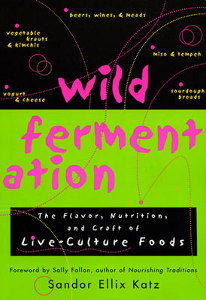Wild Fermentation
Wild Fermentation is a book by Sandor Katz that explores the art and science of fermentation. It is considered a foundational text in the field of food preservation and culinary arts. The book provides a comprehensive guide to fermenting a wide variety of foods, including vegetables, dairy, grains, and beverages.
Overview[edit | edit source]
Wild Fermentation was first published in 2003 and has since become a seminal work in the field of fermentation. The book emphasizes the importance of traditional fermentation techniques and their role in nutrition and food culture. Katz advocates for the use of wild, naturally occurring microorganisms to ferment foods, as opposed to using commercial starter cultures.
Content[edit | edit source]
The book is divided into several chapters, each focusing on different types of fermented foods. It includes detailed instructions and recipes for making sauerkraut, kimchi, yogurt, cheese, sourdough bread, and beer, among others. Katz provides historical context and cultural significance for each type of fermentation, highlighting the diversity of fermentation practices around the world.
Vegetable Fermentation[edit | edit source]
One of the key sections of the book is dedicated to vegetable fermentation. Katz explains the process of lacto-fermentation, where lactic acid bacteria convert sugars in vegetables into lactic acid, preserving the food and enhancing its flavor. Recipes for sauerkraut and kimchi are provided, along with variations and tips for experimentation.
Dairy Fermentation[edit | edit source]
In the dairy section, Katz covers the fermentation of milk into products like yogurt and cheese. He discusses the role of bacteria and enzymes in transforming milk, and provides guidance on creating different textures and flavors.
Grain Fermentation[edit | edit source]
The book also explores the fermentation of grains, focusing on sourdough bread and other fermented grain products. Katz explains the natural leavening process and the benefits of consuming fermented grains.
Beverage Fermentation[edit | edit source]
Katz includes a section on fermenting beverages, such as beer, wine, and kombucha. He describes the fermentation process for each beverage and offers recipes for homebrewers and enthusiasts.
Philosophy[edit | edit source]
Katz's philosophy in Wild Fermentation is centered around the idea of reconnecting with traditional food practices and embracing the natural world. He encourages readers to experiment with fermentation and to appreciate the unique flavors and health benefits that fermented foods offer.
Impact[edit | edit source]
Since its publication, Wild Fermentation has inspired a resurgence of interest in fermentation among home cooks and professional chefs alike. It has contributed to the growing popularity of fermented foods in Western cuisine and has influenced the development of the fermentation revival movement.
Related pages[edit | edit source]
Search WikiMD
Ad.Tired of being Overweight? Try W8MD's physician weight loss program.
Semaglutide (Ozempic / Wegovy and Tirzepatide (Mounjaro / Zepbound) available.
Advertise on WikiMD
|
WikiMD's Wellness Encyclopedia |
| Let Food Be Thy Medicine Medicine Thy Food - Hippocrates |
Translate this page: - East Asian
中文,
日本,
한국어,
South Asian
हिन्दी,
தமிழ்,
తెలుగు,
Urdu,
ಕನ್ನಡ,
Southeast Asian
Indonesian,
Vietnamese,
Thai,
မြန်မာဘာသာ,
বাংলা
European
español,
Deutsch,
français,
Greek,
português do Brasil,
polski,
română,
русский,
Nederlands,
norsk,
svenska,
suomi,
Italian
Middle Eastern & African
عربى,
Turkish,
Persian,
Hebrew,
Afrikaans,
isiZulu,
Kiswahili,
Other
Bulgarian,
Hungarian,
Czech,
Swedish,
മലയാളം,
मराठी,
ਪੰਜਾਬੀ,
ગુજરાતી,
Portuguese,
Ukrainian
Medical Disclaimer: WikiMD is not a substitute for professional medical advice. The information on WikiMD is provided as an information resource only, may be incorrect, outdated or misleading, and is not to be used or relied on for any diagnostic or treatment purposes. Please consult your health care provider before making any healthcare decisions or for guidance about a specific medical condition. WikiMD expressly disclaims responsibility, and shall have no liability, for any damages, loss, injury, or liability whatsoever suffered as a result of your reliance on the information contained in this site. By visiting this site you agree to the foregoing terms and conditions, which may from time to time be changed or supplemented by WikiMD. If you do not agree to the foregoing terms and conditions, you should not enter or use this site. See full disclaimer.
Credits:Most images are courtesy of Wikimedia commons, and templates, categories Wikipedia, licensed under CC BY SA or similar.
Contributors: Prab R. Tumpati, MD

